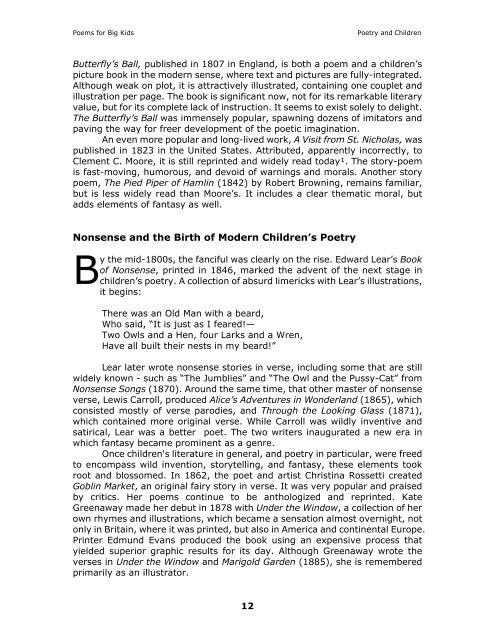You also want an ePaper? Increase the reach of your titles
YUMPU automatically turns print PDFs into web optimized ePapers that Google loves.
<strong>Poems</strong> <strong>for</strong> <strong>Big</strong> <strong>Kids</strong> Poetry and Children<br />
Butterfly’s Ball, published in 1807 in England, is both a poem and a children’s<br />
picture book in the modern sense, where text and pictures are fully-integrated.<br />
Although weak on plot, it is attractively illustrated, containing one couplet and<br />
illustration per page. The book is significant now, not <strong>for</strong> its remarkable literary<br />
value, but <strong>for</strong> its complete lack of instruction. It seems to exist solely to delight.<br />
The Butterfly’s Ball was immensely popular, spawning dozens of imitators and<br />
paving the way <strong>for</strong> freer development of the poetic imagination.<br />
An even more popular and long-lived work, A Visit from St. Nicholas, was<br />
published in 1823 in the United States. Attributed, apparently incorrectly, to<br />
Clement C. Moore, it is still reprinted and widely read today¹. The story-poem<br />
is fast-moving, humorous, and devoid of warnings and morals. Another story<br />
poem, The Pied Piper of Hamlin (1842) by Robert Browning, remains familiar,<br />
but is less widely read than Moore’s. It includes a clear thematic moral, but<br />
adds elements of fantasy as well.<br />
Nonsense and the Birth of Modern Children’s Poetry<br />
By the mid-1800s, the fanciful was clearly on the rise. Edward Lear’s Book<br />
of Nonsense, printed in 1846, marked the advent of the next stage in<br />
children’s poetry. A collection of absurd limericks with Lear’s illustrations,<br />
it begins:<br />
There was an Old Man with a beard,<br />
Who said, “It is just as I feared!—<br />
Two Owls and a Hen, four Larks and a Wren,<br />
Have all built their nests in my beard!”<br />
Lear later wrote nonsense stories in verse, including some that are still<br />
widely known - such as “The Jumblies” and “The Owl and the Pussy-Cat” from<br />
Nonsense Songs (1870). Around the same time, that other master of nonsense<br />
verse, Lewis Carroll, produced Alice’s Adventures in Wonderland (1865), which<br />
consisted mostly of verse parodies, and Through the Looking Glass (1871),<br />
which contained more original verse. While Carroll was wildly inventive and<br />
satirical, Lear was a better poet. The two writers inaugurated a new era in<br />
which fantasy became prominent as a genre.<br />
Once children's literature in general, and poetry in particular, were freed<br />
to encompass wild invention, storytelling, and fantasy, these elements took<br />
root and blossomed. In 1862, the poet and artist Christina Rossetti created<br />
Goblin Market, an original fairy story in verse. It was very popular and praised<br />
by critics. Her poems continue to be anthologized and reprinted. Kate<br />
Greenaway made her debut in 1878 with Under the Window, a collection of her<br />
own rhymes and illustrations, which became a sensation almost overnight, not<br />
only in Britain, where it was printed, but also in America and continental Europe.<br />
Printer Edmund Evans produced the book using an expensive process that<br />
yielded superior graphic results <strong>for</strong> its day. Although Greenaway wrote the<br />
verses in Under the Window and Marigold Garden (1885), she is remembered<br />
primarily as an illustrator.<br />
12



